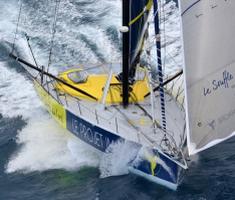 At roughly this point in the last sailing of the Vendee Globe in 2016-2017, 5 boats had been forced to retire after being damaged by collisions with UFOs, unidentified floating objects.
At roughly this point in the last sailing of the Vendee Globe in 2016-2017, 5 boats had been forced to retire after being damaged by collisions with UFOs, unidentified floating objects.
In this year’s race, 18 of the 33 boats competing are carrying a new high-tech collision avoidance package dubbed OSCAR. The electronics package, installed at the boat’s masthead, uses day and thermal cameras combined with artificial intelligence, to provide a second set of ‘eyes’ for the solo skipper both day and night.
How well has OSCAR worked so far? It may still be too soon to judge. That being said, of the 4 racing boats damaged by UFOs in the current race, at least two had OSCAR units installed.
Sam Davies, on Initiatives Coeur, was sailing at 15-20 knots when the boat’s keel struck something underwater and came to a sudden and complete stop. Structural damage forced Davies to retire from the race. Alex Thomson, on Hugo Boss, suffered rudder damage from striking something floating, forcing him to retire as well. Both boats had OSCAR systems installed aboard.
Before coming to any conclusion about the effectiveness of installing collision avoidance electronics, it may be worthwhile to consider what the UFOs are likely to be.
Not all UFOs are really unidentified. Alex Thomson reported signs of fishing nets on his damaged rudder. In the last sailing of the race, Vincent Riou was forced to retire after his boat struck a drifting steel buoy. Based on video footage taken after the collision in 2016, Kito de Pavant’s boat was damaged after hitting a sperm whale.
There is no absolute determination of what Thomas Ruyant struck that crippled and very nearly sank his boat in 2016, although based on the damage, a floating shipping container seems like a good bet.
For most of these collisions, whether the object is identified or not, it is not clear that systems like OSCAR featuring multiple cameras supported by artificial intelligence will be of any practical use.
Abandoned fishing nets and tackle, often called “ghost nets” float below the water’s surface and can easily damage the carbon fiber appendages or even the keel of a racing yacht.
Shipping containers can float just inches above the surface of the ocean and can be almost impossible to spot either visually or electronically with any sort of sea running.
Marine mammals can be killed by being run down by a racing yacht traveling at 15-30 knots and are not likely to be picked up by collision avoidance systems.
So far at least, it appears that sophisticated electronics may not yet provide an effective answer as to how to avoid collisions at sea between UFOs and high-speed racing yachts.

Whales communicate with each other with vlf sounds (I believe). Perhaps some thought should be given to identifying the positions and tracking the source of such noises or even just giving skippers a proximity alert.
And what about using forward facing sonar fish finders linked into navigation and steering electronics, that would identify any dense object and steer around it faster than a human can react to an alarm. I am thinking while writing and wondering if that would cope with waves.
Any submariners around to comment?
Jean-Pierre, those are great ideas to think about.
Forward-looking sonar will run into trouble in any kind of sea state, simplistically. But with some machine-learning to discriminate various types of returns it seems plausible.
For the mammals: really cool idea. Could be difficult in a boat running hard, but there’s a lot of keel depth in these particular vessels to get a transducer well down and deep.
Further to Jean-Pierre, by coincidence just the other day I was searching for academic articles for side-effects of sonar on marine mammals, trying to learn about what sort of impact a chirping sonar might have on our local seagoing critters (I have a burning urge to have a chirper for helping to deal with dodgy anchorages but not at any cost).
From what I read there, it seems easily possible to build a receiver capable of picking up ultrasonic sonar and signaling used by mammals. It would all come down to noise discrimination, and that’s another area friendly to machine-learning. And the range of ultrasound even in water is quite scanty, so it seems feasible that signals would be confined to reasonable proximity to the vessel.
Toehold on subject via Google Scholar: https://scholar.google.com/scholar?hl=en&as_sdt=0%2C48&q=marine+mammals+echo+sounders&btnG=